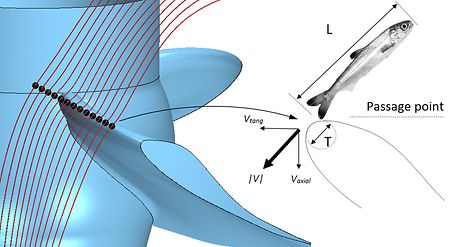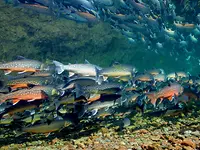Water scarcity or excess
Protecting fish and livelihoods
Fish-friendly assessment in practice
Modern hydropower developments, either new power plants or refurbishments, face strict regulatory requirements to enhance the survival of migratory fish passing though operating turbines. The earlier the stage at which fish passage studies take place, the better the prospects are for implementing effective strategies for fish survival enhancements.

This makes model-based fish passage analyses ideal for the turbine design phase and increasingly acceptable by operators and authorities. ANDRITZ is advancing simulation technology to rapidly and accurately quantify the intensity and frequency with which fish encounter hazardous flow features and walls during turbine passage (see Figure 1). While the seminal computational method was the product of ground-breaking work in research laboratories, the ANDRITZ advancement consists of streamlining biological performance (a.k.a. fish-friendliness) assessments in the turbine design process. This allows ANDRITZ design teams to develop geometries that maximize fish-friendliness while accounting for on-site needs and even targeting fish species of concern.

Picture 1: Turbine runner for Monsin hydropower plant in Belgium with strictly fish-friendly design

Picture 2: Fish-friendly runner enhancement for the Eddersheim hydropwer plant in Germ
These modern tools accompany our projects in all phases, from the general layout of a machine to the definition of its operational management to maximize fish survival. With upgraded biological assessment tools, ANDRITZ offers the possibility to configure a product that not only aims at greater efficiency but also at superior fish-friendliness, by, for instance reducing the likelihood of mortal injury of fish due to collision with runner blades. Thereafter, ANDRITZ can fulfil biological goals. Examples come from the strict fish-related properties required during the design of a Kaplan turbine for the Monsin hydropower plant rehabilitation in Belgium (see Picture 1) and the fish-friendliness enhancement of the Eddersheim power plant in Germany (see Picture 2).

Figure 1: Simulation technology for assessment of fish passing through the turbine

Figure 2: Release scenarios of live fish and sensor samples
Likewise, these novel tools support the planning of field tests with live fish and sensor devices that record extreme hydraulics though turbines. For instance, ANDRITZ evaluated release scenarios of live fish and sensor samples through a fish-friendly Kaplan machine in order to address questions pertaining to test execution, e.g., where should fish samples be released for collecting representative outcomes, and what should the sample size be (see Figure 2).
In addition, while great emphasis is made on fish survival enhancements through design, operational improvements also open doors for a more integrative management of hydropower stations. To that end, the fish-friendly tools assist in bio-hill chart (see Figure 3) calculations, which — in comparison to efficiency hill charts — represent potential survival rates of a target fish species to a specific hydraulic stressor over the entire operating range of the machine. Oil-free hubs are yet another feature embedded in ANDRITZ turbines to reduce the environmental impact of hydropower by eliminating oil pollution.

Figure 3: Bio-hill charts representing potential survival rates of fish
Fish-friendliness has also taken precedence in hydro projects in Asia. Developments on the Mekong River are perhaps the most emblematic example of a region in search of a compromise between hydropower and fish protection. The Xayaburi hydropower plant in Lao PDR, equipped with ANDRITZ equipment and successfully commissioned in 2019, features a fish-friendly turbine design with fewer runner blades, thicker leading edges and a lower rotational speed.

Fish ladder, Xayaburi hydropower plant, Lao PDR
By implementing these technologies and developments, a 90% survival rate of the fish passing through a turbine can be ensured. It should also be noted that only about 20% of all migrating fish are affected by the turbine, since the majority of the fish population are protected by other measures, such as fish ladders and bypass passages.
ANDRITZ has a strong conviction that the turbine industry plays a significant role in improving the environmental health of rivers and preserving fish biota, therefore also securing the livelihood of thousands of people living along rivers and lakes throughout Asia.
Author: Romero-Gomez Pedro de Jesus




